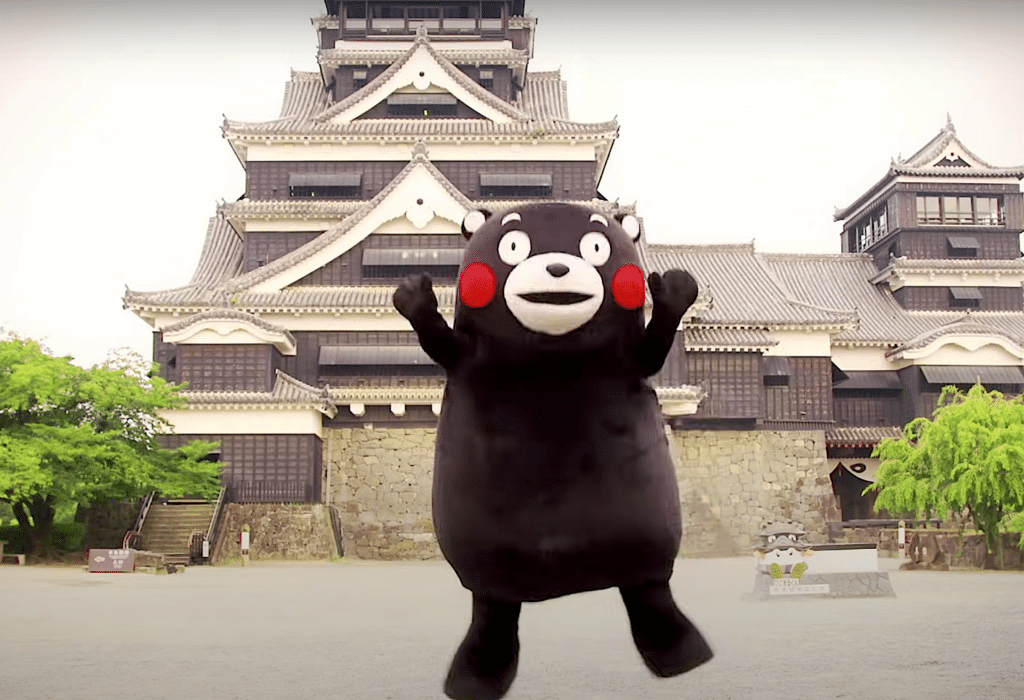
10 Famous Japanese Mascots
From adorable animals to quirky characters, Japanese mascots—or “yuru-kyara”—have captured the hearts of millions both locally and globally.
In this article, you’ll meet 10 of the most popular mascots in Japan and learn about their significance in Japanese society.
Contents
- What Are Yuru-kyara?
- Popular Japanese Mascots
- The Importance of Mascots in Japanese Culture
- And One More Thing...
Download: This blog post is available as a convenient and portable PDF that you can take anywhere. Click here to get a copy. (Download)
What Are Yuru-kyara?
Yuru-kyara (also spelled yuru-chara) are mascots that represent and promote various localities, events, businesses or products in Japan. Their name comes from the words yurui (loose or relaxed) and kyara (character).
These days, there are so many mascots that people often lose track of which is which and what entity they represent. They prance around street fairs, sporting events, community gatherings and tourist destinations.
They even had their own national competition called the Yuru-Chara Grand Prix where mascots competed for votes from the public. This event was held annually from 2010 to 2020 and ended because it was getting overly competitive!
Japanese mascots come with their own accessories and merchandise and have generated billions in revenue while attracting tourists to the various locations they represent. Many even have their own social media profiles and have gained international recognition through news sources, Japanese bloggers, popular movies and TV shows—and you can find clips on FluentU of them for additional Japanese learning assistance.
FluentU takes authentic videos—like music videos, movie trailers, news and inspiring talks—and turns them into personalized language learning lessons.
You can try FluentU for free for 2 weeks. Check out the website or download the iOS app or Android app.
P.S. Click here to take advantage of our current sale! (Expires at the end of this month.)

Popular Japanese Mascots
1. Domo-kun ( どーもくん )
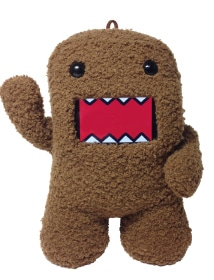
This well-loved character is the official mascot of NHK (Japan’s public broadcasting organization). He first appeared in short stop-motion sketches on NHK in 1998.
Over time, Domo-kun’s popularity expanded beyond Japan, and he became a symbol of Japanese pop culture worldwide.
He even starred in his own animated TV series produced by NHK and Nickelodeon which aired in 2008 in the U.S. and internationally.
The furry mascot has been a campaign icon for overseas companies such as Target and his merchandise often appears in popular stores like Urban Outfitters.
2. Kumamon ( くまモン )
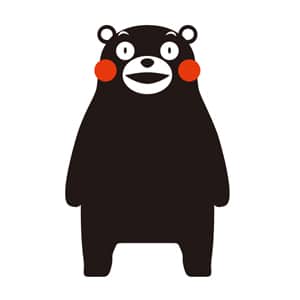
Kumamon is one of the best examples of a mascot success story. This rosy-cheeked, bear-like mascot represents Kumamoto Prefecture in southern Japan.
Since its first appearance promoting the Kyushu Shinkansen (bullet train) in 2010, Kumamon has reeled in the big bucks. Between the years 2011 and 2019, Kumamon’s merchandise sales amounted to a staggering 875.8 billion yen.
If you’ve yet to see Kumamoto’s star, you can catch a glimpse at Kumamon-themed hotels and trains, on packages of cookies and even on Japan Airline’s special “Air Kumamon” package on international flights.
3. Barii-san ( バリィさん )
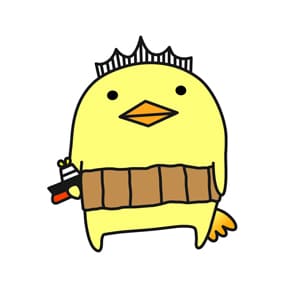
This adorable mascot represents Imabari city, Ehime Prefecture on the Shikoku island. Barii-San won first place in the 2012 Yuru-Chara Grand Prix and came in second place in 2011.
Every aspect of his appearance references a characteristic of his homeland: their main food specialty is a type of yakitori (skewered chicken) and their main product is haramaki (a cloth that wraps around the stomach).
Barii-san’s crown is the Kurushima-Kaikyō Bridge (which connects Shikoku to the mainland) and the boat-shaped wallet in his hand represents the local shipping industry.
4. Funassyi ( ふなっしー )
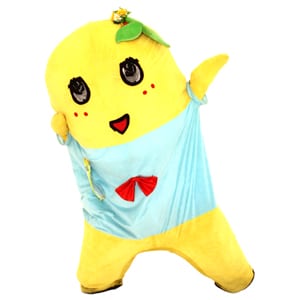
Created by a resident of Funabashi, Chiba, Funassyi now serves as the city’s unofficial representative and has become one of the most popular yuru-kyara in Japan.
A few things contribute to Funassyi’s unique pear-inspired character. Unlike most mascots, who are silent and relaxed, Funassyi talks as fast as he moves.
As a big fan of rock music, Funassyi even released a full album in 2014 and continues to appear at events and on TV, generating millions in revenue.
5. Hikonyan ( ひこにゃん )

Hikonyan represents the city of Hikone and was created in 2007 to commemorate the 400th anniversary of the founding of Hikone Castle. He wears the same samurai helmet that can be seen at the castle’s museum.
This feline character is based on a legend that says that the third Lord of Hikone was saved from a lightning strike when a white cat beckoned him to seek shelter in a temple.
The beloved mascot (and the winner of the 2010 Yuru-Chara Grand Prix) has increased annual tourist visitation of Hikone by over 200,000 and has generated hundreds of millions of dollars in revenue.
6. Sanomaru ( さのまる )
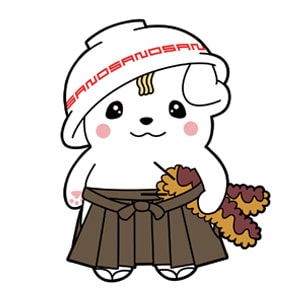
Sanomaru represents Sano City in Togichi Prefecture. He can’t get much cuter with his big, puppy eyes, his pink paws and cheeks.
He wears a bowl of ramen spilled over his head and holds another famous local food: deep-fried potato skewers (imo-furai).
He won the 2013 Yuru-Chara Grand Prix and placed 4th in 2012. Sanomaru makes appearances all over his city and shows up on merchandise across Japan and beyond.
7. Okazaemon ( オカザえもん )
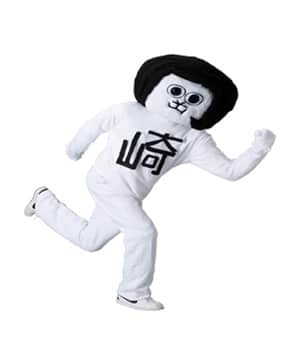
Representing Okazaki City in Aichi Prefecture, Okazaemon is a prime example of a trend of creepy-cute mascots in Japan.
Clad with helmet hair, oversized pupils and a white bodysuit, Okazemon’s strange appearance hasn’t stopped him from gaining popularity throughout Japan and generating substantial revenue.
His facial features resemble the kanji of “oka 岡” (hill) and the kanji of “zaki 崎” (Saki) is written on his chest. He even got a female counterpart in 2013, but she hasn’t gained nearly as much popularity as Okazaemon.
8. Reruhi-san ( レルヒさん )
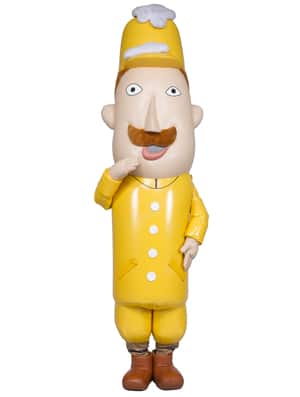
This mascot is based on Theodor Elder von Lerch, an Austrian Major General who’s credited for bringing skiing to Japan.
Reruhi-san is hard to miss as he towers over other mascots at 270cm and dons a bright yellow outfit that’s somewhere between a snowsuit and an old-fashioned pair of pajamas.
Reruhi-san represents Niigata Prefecture, an area known for its ski resorts, national parks and many hot springs. You can find him on packets of souvenirs, posters and tottering around festivals and other public events.
9. Nishiko-kun ( にしこくん )
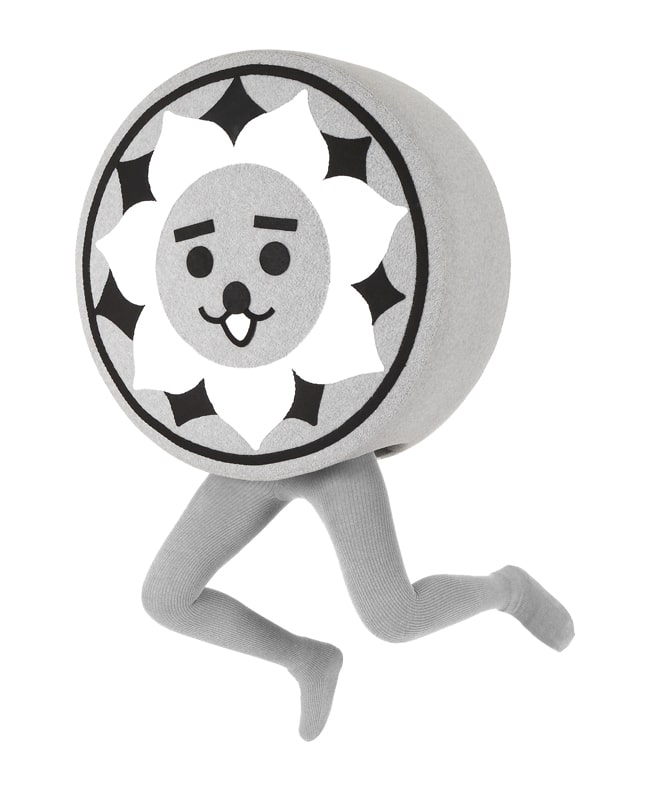
Nishiko-kun is another one of the slightly creepy but still somewhat cute Japanese mascots. The orb-shaped, spandex-wearing mascot won the hearts of many when he was awarded 3rd place in the 2011 Yuru-Chara Grand Prix.
Nishiko-kun represents the city of Nishi-Kokobunji on the outskirts of Tokyo. The character is based on kawara, a circular decorative roof tile you can find on buildings around the city.
He has no arms, but that doesn’t stop him from dancing and running around at public events.
10. Meron Kuma ( メロン熊 )
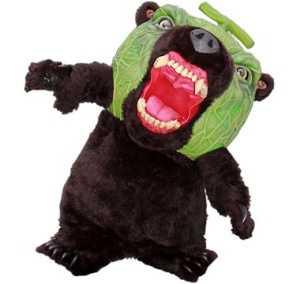
Meron Kuma is also called “Melon Bear” and is, basically, a bear with a melon for a head with some terrifying features.
He’s known for attacking other mascots and even tourists. His ferocious behavior makes him a standout at any gathering he attends.
The melon-bear combo might seem confusing, but it’s explained by the place he (unofficially) represents. Yubari City in Hokkaido is famous for its melons and its bears.
The creator of the mascot says that Meron Kuma ate some locally-grown melon and then transformed into the fantastical creature.
The Importance of Mascots in Japanese Culture
Some may argue that the significance of each mascot and what they represent has been diluted by the sheer number of mascots in existence and the frequency with which they appear. However, there’s no denying that these characters have had a huge impact on Japanese culture and continue to shape the country’s marketing and tourism industry.
Beyond the economic impact, it’s been said that the popularity of mascots in Japan is partially due to the profound emotional connection that the Japanese have to “non-human” figures, with origins deeply rooted in ancient polytheistic beliefs.
Not only do mascots help promote regional tourism, but they also educate visitors about local culture and community. They’re used for public outreach by political parties, local museums, schools and even the military. And they don’t just promote products and tourist destinations—there are mascots who fight for solar power and tax reductions.
Whether or not you’ve caught the mascot craze, you can now see why these characters are found almost everywhere you look in Japan.
Download: This blog post is available as a convenient and portable PDF that you can take anywhere. Click here to get a copy. (Download)
And One More Thing...
If you love learning Japanese with authentic materials, then I should also tell you more about FluentU.
FluentU naturally and gradually eases you into learning Japanese language and culture. You'll learn real Japanese as it's spoken in real life.
FluentU has a broad range of contemporary videos as you'll see below:

FluentU makes these native Japanese videos approachable through interactive transcripts. Tap on any word to look it up instantly.

All definitions have multiple examples, and they're written for Japanese learners like you. Tap to add words you'd like to review to a vocab list.

And FluentU has a learn mode which turns every video into a language learning lesson. You can always swipe left or right to see more examples.

The best part? FluentU keeps track of your vocabulary, and gives you extra practice with difficult words. It'll even remind you when it’s time to review what you’ve learned. You'll have a 100% personalized experience.
Start using the FluentU website on your computer or tablet or, better yet, download the FluentU app from the iTunes or Google Play store. Click here to take advantage of our current sale! (Expires at the end of this month.)


